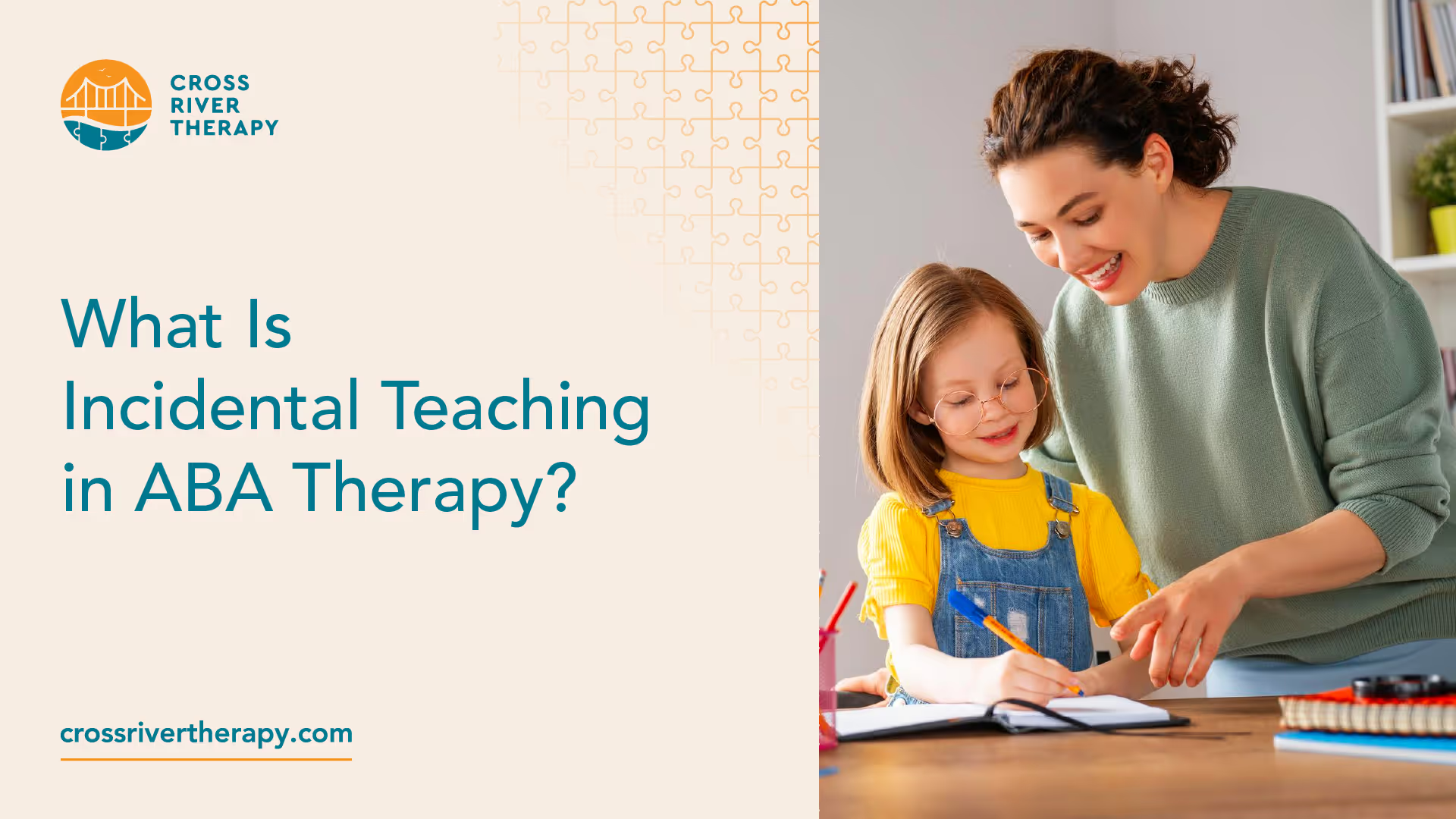What Is Incidental Teaching in ABA Therapy?
Incidental teaching is a behavioral strategy that provides advantages through learning that's naturally structured.


What is Incidental Teaching in ABA?
Using the fundamentals of Applied Behavior Analysis, incidental teaching is a behavioral strategy that provides advantages through learning that's naturally structured.
It utilizes things that interest children and naturally motivate them. It's particularly useful to parents that have young children.
During the training, a therapist allows the child to lead by picking an activity or circumstance where opportunities for them to learn will happen.
After the therapist notices a situation that occurs naturally in which the child is engrossed, different strategies are utilized to motivate them to respond.
As a result, incidental training plans are built to encourage better motivation from children, especially those that are diagnosed with behavioral disorders.
Incidental teaching can also be practiced in occupational and speech therapy, including in the treatment of more behavioral disorders. Because of this, it's not strictly a therapy for people with an autism diagnosis.
Who Is Incidental Teaching For?
Incidental teaching is primarily used for children when they're in the process of receiving therapy sessions for a specific disorder.
Even while it's not entirely suited for ABA therapy, it makes up the majority of the therapists using it.
However, it's also well suited for use with patients that are older than the target age group that benefits the most from it.
The age range of people receiving incidental teaching is between two to nine years. It can help in improving the language and communication abilities of the autistic. It's also beneficial in getting them to transfer skills over to different situations.
When combined, the biggest advantage to incidental teaching is the patient's ability to converse with people in different settings, with their peers, and with their parents.
Where Does Incidental Teaching Come From?
Since the 1970s, incidental teaching has been used in ABA therapy to treat autistic patients. It was the first technique involved in teaching during ABA sessions.
It provided a substitute for more conservative techniques, such as discrete trial training, which is much more regimented than the former. However, it's common to see both DTT and incidental teaching in the average ABA therapy center.
Does Incidental Teaching Help Autistic Children?
Studies show that incidental teaching is not only useful in the application of ABA but can provide long-term benefits to patients, even when they're done with ABA.
It allows kids to hone their speaking abilities, whether they're alone, at school, or talking with their peers in various social gatherings.
It can have a great positive impact on people with both mild and severe cases of autism, even in adults that seek out therapy.
What Are the Four Steps in Incidental Teaching?
There are several steps required for using incidental teaching, with one or more needed to help with patient communication abilities:
- Make things interesting - Parents can create an environment that they know their child would be interested in, such as an indoor play area. Again, creativity is the point here, so things like clubhouses made out of boxes, a small camper somewhere in the home or backyard, or even a makeshift part of the living room are all places that can immediately get their attention.
- Control access to something they find interesting - The possibilities for this are endless, but when used in a situation described previously, the play area could be located somewhere close, but out of reach for them, such as in a corner or room that's adjacent to the one they sleep in.
- Let them communicate on their own - Parents should wait for them to inquire about the object or area. If they cannot speak, the child may point to an interesting place or thing set up for them.
- Use prompting - To use prompting puts the child in a situation where they're encouraged to communicate to get their point across. Parents can ask their children to provide them with the answer to a certain toy that's located in the place they want to go, or the color of a toy they wish to have. They can communicate what they want by speaking it, using gestures, or even pictures.
Once the child begins to communicate, the thing set up by the parents that piques their interest can finally be provided to them.
Incidental Teaching Strategies
Here are some strategies that can be used in incidental teaching:
1. Be sure to evaluate the child
To get the most with this strategy, it's imperative that the parent or teacher understand them well and how they behave naturally. This includes the behavior they exhibit which is positive and negative.
2. Build a good learning environment
Whether teacher or parent, incidental teaching works great when the environment that's set up for the child is carefully thought out and arranged.
As such, the use of props, ornaments, materials that interest them, and fun activities can help prompt the child into responding through language, signs, and gestures.
However, whatever's being used should always be put somewhere that is out of the direct reach of the child.
Doing it, it can motivate them since the item cannot be reached by them on their own. The environment can be built using lots of items like various toys, instruments, and even books.
3. Encourage initiation
The child or client is the center of initiation teaching. All of their interactions while initiation teaching should be started by the child, not the parents, teacher, or therapist.
4. Using prompts
When a child doesn't initiate, the parents or teacher can assist them through the use of prompting. This can be done by asking them questions that are related to the activity that's out of their reach. However, communication can also be carried out nonverbally.
Examples of Incidental Teaching
A primary example of incidental teaching is when a parent buys a racing car set and places it on the top of a large cupboard in the home. The child has no way to reach or touch it, though they can easily see what's there.
The child then points to the top of the cupboard, whereby the parent encourages them to say the name of the toy.
When the child correctly says the name, the racing set can then be taken down and given to the child. If they're unable to speak it properly, the child can identify it through a photo shown to them.
Recent News
Related articles

Working With Autistic Children: 10 Career Options
Want to work with autistic children? Here are 10 career options for you to consider.

What Is The Age Limit For ABA Therapy In Indiana?
Find out what the age limit is for receiving Applied Behavior Analysis (ABA) therapy in Indiana.

What Is The Age Limit For ABA Therapy In Arizona?
Find out what the age limit is for receiving Applied Behavior Analysis (ABA) therapy in Arizona.

Verbal Operants In ABA: Definition & Examples
In Applied Behavior Analysis, verbal operants are a type of verbal behavior.

Token Economy: Examples & Applications in ABA
A token economy is a procedure that was developed to help reduce maladaptive behaviors and increased desire behaviors by providing a tangible conditioned reinforcer.

Trigger Analysis In ABA: Definition & Examples
Trigger analysis is a segment of ABA therapy where children are taught by therapists to pinpoint the behaviors and emotions that happen before, during, and after an event that takes place.

Variable Ratio Schedule & Examples
A variable-ratio schedule is a random reinforcement where responses are reinforced following varied responses afterward.

Task Analysis In ABA Therapy: Examples & Strategies
Task analysis is a process of teaching that divides complicated activities into sections involving easier steps for students to more easily take.

Stimulus Equivalence In ABA: Definition & Examples
Stimulus equivalence shows how relationships can manifest among different types of stimuli in different situations.

Speech Therapy For Autism: ABA vs. Speech Therapy
ABA therapy can help individuals with speech impairments learn to better identify and utilize the language skills they already have.

Stimulus Control Transfer ABA: Definition & Examples
Stimulus control is defined as an expression used to detail circumstances where a behavior is triggered by the existence or absence of a stimulus.

Social Validity In ABA: Definition & Examples
Social validity is the acceptance of interventions concerning behavioral changes.

